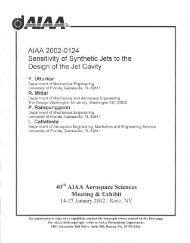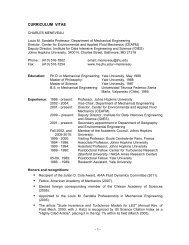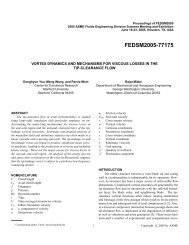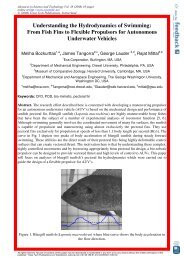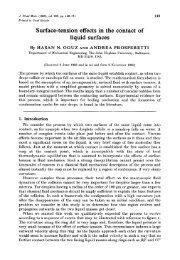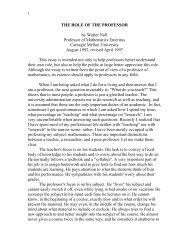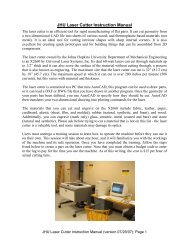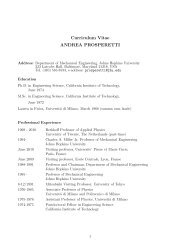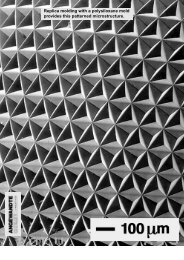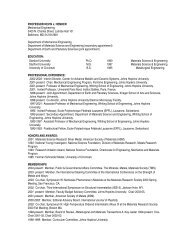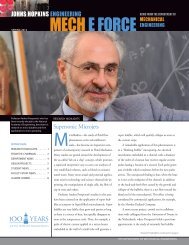A Sharp Interface Cartesian Grid Method for Simulating Flows with ...
A Sharp Interface Cartesian Grid Method for Simulating Flows with ...
A Sharp Interface Cartesian Grid Method for Simulating Flows with ...
Create successful ePaper yourself
Turn your PDF publications into a flip-book with our unique Google optimized e-Paper software.
SHARP INTERFACE CARTESIAN GRID METHOD 377<br />
4. SUMMARY<br />
A method <strong>for</strong> simulating flow around complex moving boundaries on <strong>Cartesian</strong> grids has<br />
been presented. The advantage of the method is that since the body motion is independent of<br />
the mesh, problems associated <strong>with</strong> mesh reconfiguration and motion are circumvented. One<br />
key aspect of the current method is that the moving immersed boundary is represented as a<br />
sharp interface and this makes the method well suited to convection-dominated problems.<br />
The fractional-step method has been re<strong>for</strong>mulated in the context of the current Eulerian–<br />
Lagrangian approach; details of this have also been discussed. A unique problem that arises<br />
in these fixed grid, sharp interface methods is the temporal discretization of the governing<br />
equations in the so-called freshly cleared cells. These are cells which were in the solid at<br />
one time step but emerge into the fluid at the next. A consistent and systematic remedy <strong>for</strong><br />
such cells has been presented.<br />
The convergence of a conventional line-SOR iterative solver has been accelerated by<br />
using a modified multigrid algorithm that appropriately accounts <strong>for</strong> the presence of the<br />
sharp, immersed boundary. In this method, a volume-fraction-type approach is applied <strong>for</strong><br />
restriction, prolongation, and smoothing at the coarser levels and this removes any need <strong>for</strong><br />
explicit reconstruction of the immersed boundary on the coarse grids levels. The per<strong>for</strong>mance<br />
of the multigrid vis-à-vis a single grid-level LSOR has been shown in the immersed<br />
boundary cases to be comparable to that <strong>for</strong> the method <strong>with</strong>out immersed boundaries. Furthermore,<br />
the multigrid method has been shown to per<strong>for</strong>m well <strong>for</strong> increasing complexity<br />
of the geometry caused by multiple boundaries embedded in the domain. A consequence of<br />
this is that the boundary motion does not lead to a significant increase in the required CPU<br />
time.<br />
The solver is used to simulate two problems that have reliable experimental data <strong>for</strong><br />
comparison. The first problem, namely the flow in a channel <strong>with</strong> a moving indentation<br />
in one wall, serves as a benchmark <strong>for</strong> techniques that simulate the interaction of moving<br />
solid boundaries <strong>with</strong> viscous, incompressible fluids. It is found that our computed results<br />
match very well the experimental and numerical data of Pedley and co-workers [34, 38]. In<br />
particular, the propagation speed of the eddies and the time and location of their breakup<br />
into smaller eddies are predicted correctly. The second case used <strong>for</strong> validation is flow past<br />
a cylinder oscillating transversely in a freestream. Simulations have been carried out over<br />
a range of oscillation frequencies and amplitudes and the frequency–amplitude envelope<br />
where vortex-shedding lock-on is observed matches well <strong>with</strong> the experiments of Koopman<br />
[26]. As a demonstration of the flexibility and efficiency of the method, flow has also been<br />
simulated in a model of a diaphragm-driven micropump containing complex stationary as<br />
well as moving immersed boundaries.<br />
REFERENCES<br />
1. R. E. Alcouffe, A. Brandt, J. E. Dendy, and J. W. Painter, The multi-grid method <strong>for</strong> the diffusion equation<br />
<strong>with</strong> strongly discontinuous coefficients, SIAM J. Sci. Stat. Comput. 2, 430 (1981).<br />
2. A. S. Almgren, J. B. Bell, P. Colella, and T. Marthaler, A <strong>Cartesian</strong> grid projection method<br />
<strong>for</strong> the incompressible Euler equations in complex geometries, SIAM J. Sci. Comput. 18, 1289<br />
(1997).<br />
3. D. M. Anderson, G. B. McFadden, and A. A. Wheeler, Diffuse interface methods in fluid mechanics, Ann.<br />
Rev. Fluid Mech. 30, 139 (1998).



